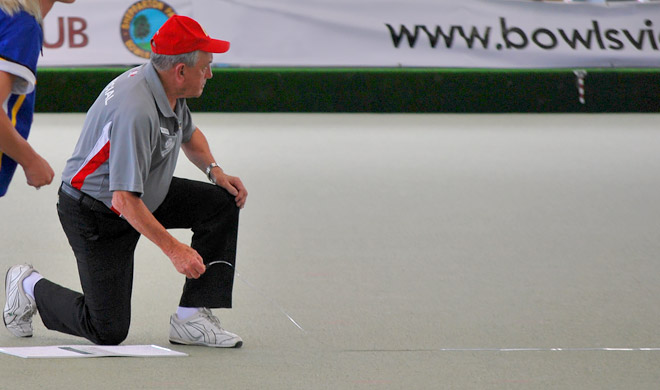The Lawman – Umpires, Officials or Police?
I have often been approached about why don’t umpires or officials enforce the Laws of the Sport. With increasing exposure of bowls on TV, which is great for our sport, it enables more armchair experts to form an opinion. Over the years I have often been approached personally or whacked via Facebook about why don’t umpires or officials enforce the Laws of the Sport. It’s usually around issues relating to possession of the rink, position of players (Laws 13 and 12) and foot faulting (Laws 7.3 and 8). With increasing exposure of bowls on TV (which is great for our sport) enables more armchair experts form an opinion.
The query is generally about differences of opinion as to whether a bowler can follow their bowl and where they must be when their bowl comes to rest.
The Laws of the Sport make no specific reference to a bowler following their bowls. However some Conditions of Play can control the movement of players and in these cases officials must ensure these conditions are followed. Usually by a quiet simple reminder.
The Laws of the Sport only refer to where a player must be when not in possession of the rink. Law 13 describes that possession of the rink belongs to the team whose bowl is being played. This law continues on to state that possession of the rink transfers to the opposing team when each bowl has come to rest, with time allowed for marking any touchers.
How many times when your skipping or playing third in Pennant does your opposition player after their bowl has comes to rest continues to indicate who has shot and how many. Once the bowl stops possession immediately swaps sides.
Law 12 specifies that players not delivering a bowl must stand at least 1 metre behind the mat. At the head you must stand behind the jack if they are in possession of the rink, behind the jack and away from the head if not in possession of the rink. On the surrounds if the jack is in the ditch or well clear of the head if this is not possible.
The player who has delivered a bowl may follow their bowl – unless otherwise stated in the competition’s conditions of play. However the player must be mindful that possession of the rink passes to their opposition when the bowls comes to rest (or marked as a toucher). At that point in time that player must be 1 metre behind the mat or behind the head.
The purpose of the law is to ensure the next to play is not impeded in anyway in playing their bowl.
Bowlers are often taught by their coaches to take a step forward as the final part of their delivery. In doing this they move down the green a little and watch the path of their bowl. This is quite acceptable so long as this player is behind the mat when their bowl comes to rest.
It is the player that keeps meandering down the green and often gets nearly halfway and then wanders back to the mat or trots their way to the head – both after their bowl has come to rest. This is not acceptable and not within the laws of the sport. This should be challenged by players and then an umpire called for if required. No player should hold up play in this way.
The question sometimes put by umpires is “what can I do about it?”
Umpires are not meant to be police officers. They are appointed to ensure the game is played in accordance with the Laws of the game (Law 43.2.5) and in a spirit of good sportsmanship.
An effective umpire would do nothing about a player who breached the law of possession unless the opponent objected about their opponent’s behaviour. Then the umpire would quietly warn the player (or coach / manager if there was one) that they had observed a breach of the rink possession law and ask that they comply.
If the umpire observes further breaches they should be completely satisfied that the player was attempting to gain an unfair advantage or was deliberately ignoring the warning before invoking the penalty for subsequent infringement. (Law 13.3.2)
A similar process would to be followed if the breaches of possession of the rink were related to provisions listed in the conditions of play. The Controlling Body may request umpires to enforce the ruling as there are often time limited games and this ploy could be used as time wasting to their advantage.
Foot faulting (Law 8) is where comments often pointed at officials. When umpires are playing in the game they are officiating (like Pennant) it is near impossible to officiate around Law 8.
It is not uncommon to receive comments like “I watched the televised finals from the Australian Open or even the Commonwealth Games and so and so definitely foot faults! Why doesn’t the umpire penalise the player or do anything about it? I can see it, why can’t they? Do the elite players have different rules to us?”
Firstly the answer is yes, the Laws of the Sport are the same for all of us. However similar to possession of the rink scenario the questions I’d ask would be: Is the player breaching the laws deliberately for unfair advantage or to cheat? Has the opponent complained to the umpire? Has the umpire spoken to the coach or the player and given a warning? If the consistent response is yes then the appropriate penalty should apply, (Law 8.2, 8.3. 8.4).
The alleged foot faulting usually applies to driving the bowl and without freeze frame cameras and monitors it would be impossible to determine unless it is blatant. Do we introduce video reviews like in the AFL or NRL?
I have had still photographs of players foot faulting sent to me and yes it shows that the player/s breached Law 8. In these situations, and particularly with elite players, contact is made with the players through their coaches. These notifications have been appreciated by all parties.
So umpire, official or police officer? It is all about how effective umpires operate. A good umpire in any sport should not have any impact on the result or the game. All players should play within the laws of the sport. Highly effective officials are authoritative and not authoritarian. Are you an umpire or a police officer?
Happy Officiating.
John Roberts
Chairman State Umpiring Committee




